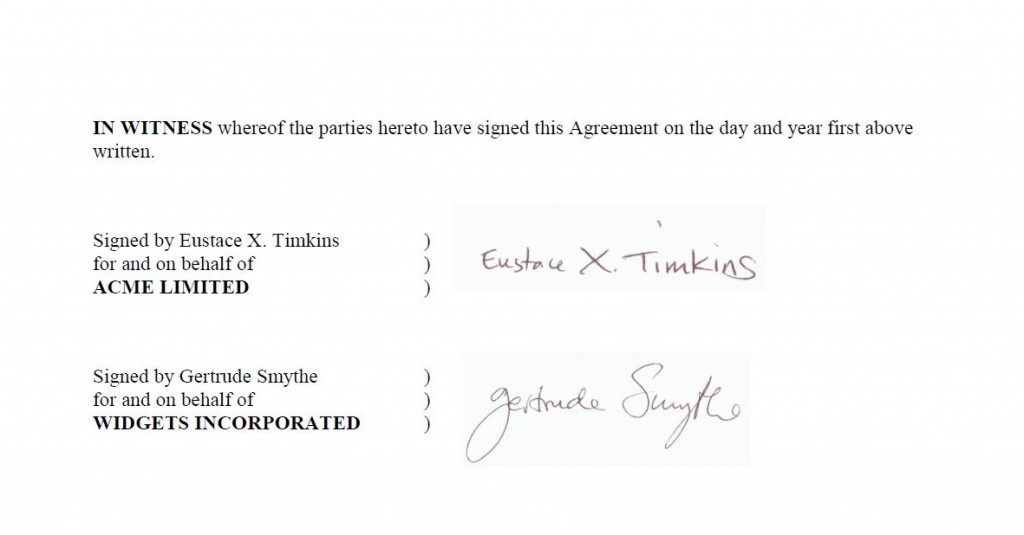Yesterday I saw an English template contract that had in the signature blocks three brackets (or rather, closing parentheses) one on top of the other. I recall Mark Anderson (aka @IPDraughts) have mentioned that practice at some point, so I asked him about it again. Here’s what he said:
You are supposed to sign in the space to the right of the brackets. To the left, should be typed:
Signed by Joe Bloggs
On behalf of
General Trading LimitedThis is a very trad style which is gradually going but still has some life in it.
Sometimes a party will sign after “signed by”, particularly if this space has not been completed with the individual’s name.
Below is my mockup of what this would look like:


The “for and on behalf of” ought to be another eyeball-roller.
I suspect the brackets were the closest a manual typewriter could get to the older style of a single, hand-written bracket, known as squiggly brackets in the US?, as in the examples to be found here:
http://blogs.lib.ku.edu/spencer/tag/apprenticeship-agreements/
Bring back squiggly brackets!
Ken:
The most common-sense version of a blank signature block that I have ever seen was as follows:
Signed: ______________
For: _________________
By: __________________
Its: __________________
On: __________________
But even that can be confusing to many business people. I just think there’s no right answer.
Chris
Hey Chris, may I suggest that “Title” replace “Its”? When I was in-house counsel, I had numerous business clients ask me what “Its” meant. Ha.
With all due respect, I’m not sure you got it right. At least here, in Canada, I see it frequently with the following format (and have never seen it as in your example): To the right of the parentheses is a signature line. Above the signature line is “Acme Limited”. To the immediate left of the line is “per”. Under the line is “I have authority to bind the corporation” as well as the signatory’s name. To the left of the parentheses is another signature line, this one for the witness (notice the text “in witness whereof”). Underneath this signature line is typically “Name:” for the insertion of the printed witness name.
If Mark Anderson thinks my illustration reflects how it’s handled in England, that’s good enough for me! There are no doubt many variants.
If the signatures are to be witnessed (as may be required if the document is executed as a deed), there would also be a space below each signature block on the left hand side, with wording such as “in the presence of:” and below that a signature block for the witness to sign (signature, address and, sometimes, occupation).
Hi Ken,
I too have had lots of general, “should have been taught in high school” issues with the public including the executives. Many ITS questions and explaining the difference between an acknowledgement and a Jurat. Also when giving the oath I noticed most American callers answer “YES” despite being informed to answer “I SWEAR” or “I AFFIRM”.
If contracts are the vehicles of business people and we are now a country of mostly forced entrepreneurs and now parents; modern parents are now asked to notarized all sorts of documents concerning their children throughout their life, document literacy has become a very basic element of citizenry and should be widely known. I say keep the ITS and teach the masses one instance at a time. SAY YES TO EDUCATION
“ITS” in Latin would most likely refer to “”Locus Sigilli”” which means “place of the seal,” indicating where a seal or signature should be affixed on a document; often abbreviated as “L.S.”. A Corporate officer’s seal would be there signature and title.